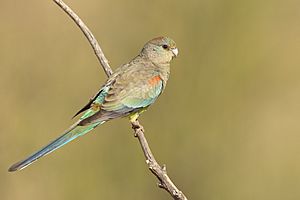Mulga parrot facts for kids
Quick facts for kids Mulga parrot |
|
|---|---|
 |
|
| male | |
 |
|
| female | |
| Conservation status | |
| Scientific classification | |
| Genus: |
Psephotellus
|
| Species: |
varius
|
| Synonyms | |
|
Psephotus multicolor |
|
The mulga parrot (Psephotellus varius) is a colorful bird found only in the dry, bushy areas and grassy woodlands of inland southern Australia. The male mulga parrot has many bright colors, which is why it was once called the many-coloured parrot.
Contents
About the Mulga Parrot's Name
The mulga parrot got its current scientific name, Psephotellus varius, from an American zoologist named Austin Hobart Clark in 1910. Before this, its name was Psephotus multicolor. This old name was changed because it had already been used for a different bird species.
Scientists have studied the mulga parrot's family tree. A genetic study in 2011 showed that the mulga parrot is closely related to the red-capped parrot. These two parrot types separated from each other a very long time ago. They are also related to the hooded and golden-shouldered parrots.
In 2018, another study looked at the genes of mulga parrots from different places. It found that there are two main groups of mulga parrots. These groups separated about 402,000 years ago. The Flinders Ranges and Eyre Peninsula in Australia seem to have kept these two groups apart. Scientists think the eastern group might have a brighter red patch on its belly.
In the 1800s, this bird was often called the "many-coloured parakeet" or "many-coloured parrot." In 1926, the RAOU (a bird organization) suggested the name "mulga parrot." Other common names include "various parrot" and "varied parrot."
A study in 2015 looked at mulga parrot specimens from museums. It found that the bills of male mulga parrots grew about 10.7% bigger between 1871 and 2008. This might be because of something called Allen's rule. This rule suggests that animals in warmer places might have larger body parts, like bills, to help them cool down.
What Mulga Parrots Look Like
The mulga parrot is a medium-sized parrot with a slim body and a long tail. It is about 27 to 32 centimeters (10.5 to 12.5 inches) long. Its wingspan is about 30 to 42 centimeters (12 to 16.5 inches), and it weighs about 50 to 60 grams (1.8 to 2.1 ounces).
Male and female mulga parrots look quite different. This is called being sexually dimorphic. The male mulga parrot is very colorful. It is mostly bright green with a bluish tint on its neck and above its eyes. Its chest is a lighter green, and its lower back is light green too.
The male has a yellow forehead and a red patch on the back of its head. Its lower belly and thighs are yellowish with orange-red markings. Its wings are mostly greenish, but they have yellow feathers in the middle and blue on the outer edges. The long tail has many colors: the two longest middle feathers are dark blue with a green tint. The outer tail feathers are blue that fades to white, and there is some red on the upper tail feathers. The male's beak is blue-grey with black edges, and its eyes are brown.
The female mulga parrot is not as bright as the male. Her head and chest are olive-brown, and her yellow forehead and red head patch are duller. Her belly is pale green, and her beak is more brown-grey. Sometimes, the female also has a red patch on her shoulder.
Where Mulga Parrots Live
Mulga parrots live in the dry inland parts of Australia. You can find them from western New South Wales, across South Australia, and into the drier central areas of Western Australia.
These parrots usually live in pairs. They prefer dry grasslands and areas with mulga scrubland.
Reproduction
Mulga parrots usually breed between July and December. They might also breed after it rains. They can raise one or sometimes two groups of young, depending on how much rain there has been.
They make their nests in hollows inside trees. The female lays a clutch of four to six white eggs. Each egg is about 22 by 18 millimeters (0.87 by 0.71 inches).
The female parrot sits on the eggs to keep them warm. This takes about 18 to 21 days. The male parrot brings food to the female while she is on the nest.
See also
 In Spanish: Perico variado para niños
In Spanish: Perico variado para niños



